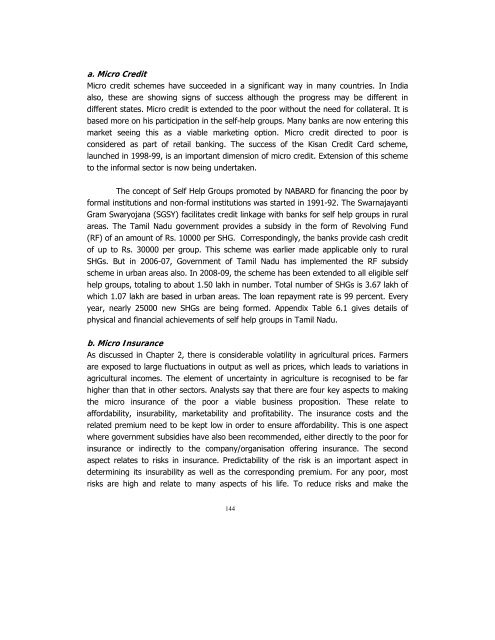POVERTY REDUCTION STRATEGY TN
Create successful ePaper yourself
Turn your PDF publications into a flip-book with our unique Google optimized e-Paper software.
a. Micro Credit<br />
Micro credit schemes have succeeded in a significant way in many countries. In India<br />
also, these are showing signs of success although the progress may be different in<br />
different states. Micro credit is extended to the poor without the need for collateral. It is<br />
based more on his participation in the self-help groups. Many banks are now entering this<br />
market seeing this as a viable marketing option. Micro credit directed to poor is<br />
considered as part of retail banking. The success of the Kisan Credit Card scheme,<br />
launched in 1998-99, is an important dimension of micro credit. Extension of this scheme<br />
to the informal sector is now being undertaken.<br />
The concept of Self Help Groups promoted by NABARD for financing the poor by<br />
formal institutions and non-formal institutions was started in 1991-92. The Swarnajayanti<br />
Gram Swaryojana (SGSY) facilitates credit linkage with banks for self help groups in rural<br />
areas. The Tamil Nadu government provides a subsidy in the form of Revolving Fund<br />
(RF) of an amount of Rs. 10000 per SHG. Correspondingly, the banks provide cash credit<br />
of up to Rs. 30000 per group. This scheme was earlier made applicable only to rural<br />
SHGs. But in 2006-07, Government of Tamil Nadu has implemented the RF subsidy<br />
scheme in urban areas also. In 2008-09, the scheme has been extended to all eligible self<br />
help groups, totaling to about 1.50 lakh in number. Total number of SHGs is 3.67 lakh of<br />
which 1.07 lakh are based in urban areas. The loan repayment rate is 99 percent. Every<br />
year, nearly 25000 new SHGs are being formed. Appendix Table 6.1 gives details of<br />
physical and financial achievements of self help groups in Tamil Nadu.<br />
b. Micro Insurance<br />
As discussed in Chapter 2, there is considerable volatility in agricultural prices. Farmers<br />
are exposed to large fluctuations in output as well as prices, which leads to variations in<br />
agricultural incomes. The element of uncertainty in agriculture is recognised to be far<br />
higher than that in other sectors. Analysts say that there are four key aspects to making<br />
the micro insurance of the poor a viable business proposition. These relate to<br />
affordability, insurability, marketability and profitability. The insurance costs and the<br />
related premium need to be kept low in order to ensure affordability. This is one aspect<br />
where government subsidies have also been recommended, either directly to the poor for<br />
insurance or indirectly to the company/organisation offering insurance. The second<br />
aspect relates to risks in insurance. Predictability of the risk is an important aspect in<br />
determining its insurability as well as the corresponding premium. For any poor, most<br />
risks are high and relate to many aspects of his life. To reduce risks and make the<br />
144

















